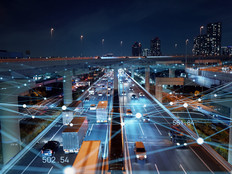A Sensible Solution
Wireless sensors help South Bend fix a messy sewage overflow problem.
.jpg)
Brent Hussung relies on a mesh network to monitor South Bend’s waste and water facilities.
Stephen Hill
Most of us prefer not to think about it, but sewage poses serious public health risks. Untreated waste spilling into waterways can taint drinking water and harm wildlife. The Environmental Protection Agency estimates that this problem plagues as many as 772 U.S. cities saddled with older infrastructure that channels storm runoff and sewage into a shared system.
South Bend, Ind., is one such city. Big storms would send a surge of rain water through the city’s overburdened waste system, dumping raw sewage into the nearby St. Joseph river. That was bad enough, but the alternative was even worse: If the overflow didn’t drain into the waterway, the excess storm water and sewage would back up into homes and businesses.
The city struggled with this scenario for years, but recently solved the problem with the help of engineers from nearby Notre Dame and Purdue universities. By installing 125 wireless sensors underneath manhole covers citywide, South Bend workers can monitor the sewer infrastructure’s depth and flow rates.
South Bend’s Combined Sewer Overflow Network (CSOnet), a smart sewage control system, is the first of its kind. The city is rolling out CSOnet in phases, with the initial focus on monitoring. “Before we can eliminate the CSOs, we have to get an accurate idea of what’s happening in the collection system,” says Brent Hussung, system specialist for the city.
The next phase will integrate smart valves and overflow reservoirs that will enable the city to control what happens within the system. Eventually, CSOnet will ensure that all waste water reaches sewage treatment plants and that raw sewage never runs off into the local waterway.
The harsh below-ground sewer environment presented a number of challenges, including how to power the sensors and how to avoid interference and obstacles as the sensors communicated. Where power lines were available, the city hard-wired the sensors into the power grid. In more remote settings, the sensors run on long-life batteries.
The sensors communicate with one another over an ad-hoc wireless mesh network developed by Purdue University and local startup EmNet. The ad-hoc network helps the distributed sensors avoid interference and physical obstacles that could diminish wireless signals. The sensors feed information back to centralized “gateway nodes,” which have cellular data cards and periodically send information over the cellular WAN to the city’s IT staff.
Growth Spurt
According to market research firm Western Technology Research Solutions, the demand for wireless sensor networks will grow to more than 400 million nodes by 2013, a 90 percent compound annual growth rate.
“What’s driving most deployments is energy management. As costs increase, sensor networks allow you to pinpoint places where automation can save money immediately,” says George West, president and senior analyst for WTRS in Mountain View, Calif.
West notes that sensor networks can also provide environmental benefits. For instance, sensor networks can be deployed around chemical plants to monitor air quality. “The advantage with wireless is that it’s mobile and flexible. You don’t have to build a physical network, and as conditions change, you can move sensors or issue new ones without much trouble,” he says.
Water monitoring isn’t South Bend’s only innovative wireless initiative. The city is in the early stages of deploying a larger wireless mesh network from Firetide. The mesh allows the city to monitor waste and water facilities. For now, it’s a cost-cutting initiative because data is currently sent over expensive leased lines. Eventually, it will provide more detailed monitoring and control and allow the city to cut costs even further by migrating its CSOnet gateway nodes away from cellular networks to the city’s more cost-effective mesh network.
“Now, we’re just doing basic monitoring [with the Firetide mesh],” Hussung says. “What are the levels? Are there pump failures? In the future, we’ll be able to monitor for other alarms, such as illegal entries. We could even install IP cameras to get visual feedback. Really, it’s just limited by our imaginations.”
Sensors Dot The Cityscape
State and local governments tap self-organizing wireless sensor networks (WSNs) for everything from monitoring bridges for stress and cracks in Boston to detecting wildlife near busy highways and warning drivers in Colorado.
“In many cases, local governments are the early adopters for this technology,” says Mareca Hatler, director of research and senior market analyst for ON World, a market research firm dedicated to emerging wireless markets. Public safety, parking management and environmental controls are some of the most common applications for WSNs in government settings.
Energy management is the leading application overall, but mostly in the private sector. In the public sector, utilities are adopting smart meters and even smart home networks, which allow them to shut off nonessential appliances such as air conditioners when the power grid is overburdened. Consumers and businesses are typically rewarded with credits on their utility bills — and with fewer rolling brownouts or blackouts — for participating in these programs.
Cities are also adopting energy management strategies as part of an emerging “smart cities” trend, according to ON World. Green buildings, the tracking of public safety employees, street light monitoring, traffic light monitoring and parking enforcement are all being handled via WSNs. As the technology matures and as some of these applications move from the proprietary realm to the Internet, expect citizens to start playing a role, helping to make smart cities even smarter.
Is that traffic light on your corner staying red too long when no cars are on the side street? Is the street light outside of your apartment coming on before sundown? Is the parking meter you just fed quarters into broken? Soon, you may be able to log into a website and report that information, saving yourself time and your city money.






